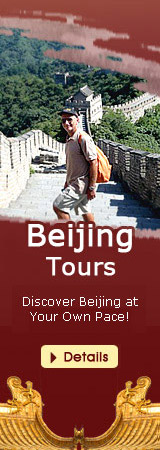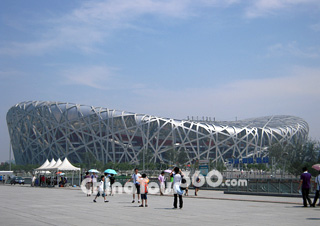 Overall View of Bird's Nest
Overall View of Bird's Nest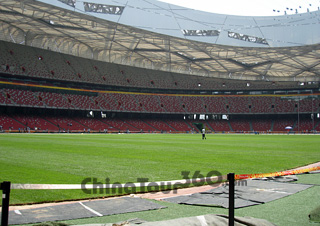 Inside of Bird'd Nest
Inside of Bird'd Nest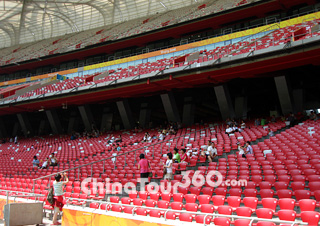 Stands in Bird's Nest
Stands in Bird's Nest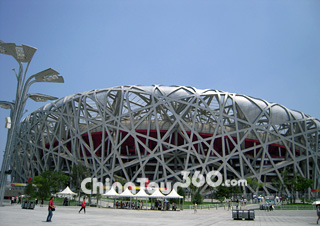 Nearby View of Beijing Bird's Nest
Nearby View of Beijing Bird's Nest
Dubbed as the Bird's Nest, China National Stadium is located at the southern part of the Olympic Park in Beijing with an area of 21 hectares. It is the main stadium of the 2008 Beijing Olympics. The notion of the design originated from the study of Chinese ceramics, which implemented steel beams in order to hide supports for the retractable roof; giving the stadium the appearance of a 'Bird's nest'. It is arguably the most impressive structure for the Beijing Olympics.
Through accurate calculation, careful argumentation, years of hard work, the Bird's Nest was successfully set up and achieved its commitment to everyone's expectation.
The stadium is 330 meters (361 yards) long by 220 meters (241 yards) wide, and is 69.2 meters (227 feet) tall. The framework of the National Stadium has been designed to stand for 100 years. Its fire resistance capability is first-rate, and it is able to withstand an eight-magnitude earthquake. The water-resistance capability of its underground project is also first-class.
The large steel skeleton of the project has the weight of 42,000 tons, with the roof and the hanging parts around it accounting for 11,200 tons. To bear such a heavy load, 78 supporting structures were temporarily installed and distributed in different points under stress, i.e. 24 supporting structures along the outer circle, 24 in the middle circle and 30 in the inner circle.
The stadium's stand has a concrete framework. The upper part of the stand and the stadium's steel structure are separated from each other, but both are based on a joint footing. The roof of the National Stadium is covered by a double-layer membrane structure, with a transparent ETFE membrane fixed on the upper part of the roofing structure and a translucent PTFE membrane fixed on its lower part.
The eastern and western stands of Beijing National Stadium are higher than northern and southern stands, in order to provide better view for spectators. Pipes placed under the playing surface gather heat in the winter to warm the stadium and coldness in the summer to cool the stadium. While the rain is to be collected for rainwater recuperation, the sunlight is to filter through the translucent roof, allowing the lawn to get essential ultraviolet radiation. On the facade, the inflated cushions are mounted on the inside of the structure where necessary, e.g. to provide wind protection. All the facilities that can bring much convenience have been taken into the design of such a huge project. It is a self-contained unit including the restaurants, shops, restrooms, suites etc.
In the original design, the stadium called for a capacity of 100,000 people; however 9,000 were removed during a simplification of the design. The new total of 91,000 was shaved further when 11,000 temporary seats were removed after the 2008 Olympics, bringing the stadium's capacity to 80,000.
Beijing National Stadium - Bird's Nest hosted the Opening and Closing Ceremonies, athletic events, and football final of the 2008 Summer Olympics, from 8 August to 24 August 2008. The Opening and Closing ceremonies and athletic events of the 2008 Summer Paralympics from 6 September to 17 September 2008 were also held here smoothly. In the future the stadium will continue to host sporting events, and it will become a large-scale sports and entertainment facility for the residents of Beijing - an architectural landmark and Olympic legacy.
![]() Entrance Fee: CNY 50 (for visiting National Stadium)
Entrance Fee: CNY 50 (for visiting National Stadium)
A. Skiing: CNY 80 (on weekdays); CNY 140 (on weekends and public holidays)
B. Through Ticket for National Stadium and Skiing: CNY 120 (on weekdays);
CNY 180 (on weekends and public holidays)
![]() Transportation:
Transportation:
![]() Take Bus No. 380, 405, 408, 415 or 518 and get off at Huizhongli Stop;
Take Bus No. 380, 405, 408, 415 or 518 and get off at Huizhongli Stop;
![]() Take Bus No. 108, 124, 328, 358 (Interzone), 379, 380, 387, 406, 408, 407, 426, 430, 479, 653, 694, 758, 803, 849, 850, 858, 984, 985, Te 2 or Express 3 and get off at Anwai Street (An Wai Da Jie) Stop;
Take Bus No. 108, 124, 328, 358 (Interzone), 379, 380, 387, 406, 408, 407, 426, 430, 479, 653, 694, 758, 803, 849, 850, 858, 984, 985, Te 2 or Express 3 and get off at Anwai Street (An Wai Da Jie) Stop;
![]() Take Bus No. 207 or 417 and get off at Beichen East Road (Bei Chen Dong Lu) Stop;
Take Bus No. 207 or 417 and get off at Beichen East Road (Bei Chen Dong Lu) Stop;
![]() Take Bus No. 510 or 839 and get off at North of Beichen Western Bridge (Bei Chen Xi Qiao Bei) Stop;
Take Bus No. 510 or 839 and get off at North of Beichen Western Bridge (Bei Chen Xi Qiao Bei) Stop;
![]() Take Bus No. 108, 124, 328, 358, 358 (Interzone), 379, 380, 387, 406, 408, 419, 426, 430, 479, 653, 694, 758, 803, 849, 858, 984, 985 or Te 2 and get off at Anhui Bridge North (An Hui Qiao Bei) Stop;
Take Bus No. 108, 124, 328, 358, 358 (Interzone), 379, 380, 387, 406, 408, 419, 426, 430, 479, 653, 694, 758, 803, 849, 858, 984, 985 or Te 2 and get off at Anhui Bridge North (An Hui Qiao Bei) Stop;
![]() Take Bus No. 113, 386, 407, 656, 660, 689, 753, 939, 944 (Branch), 983 (Branch) or Yuntong 113 and get off at Beichen Bridge West (Bei Chen Qiao Xi) or the Asian Games Village Stop;
Take Bus No. 113, 386, 407, 656, 660, 689, 753, 939, 944 (Branch), 983 (Branch) or Yuntong 113 and get off at Beichen Bridge West (Bei Chen Qiao Xi) or the Asian Games Village Stop;
![]() Take Subway Line 8 and get off at Olympic Sports Center Station.
Take Subway Line 8 and get off at Olympic Sports Center Station.



